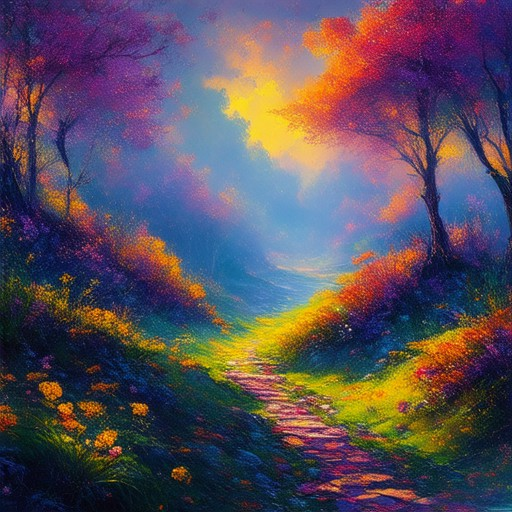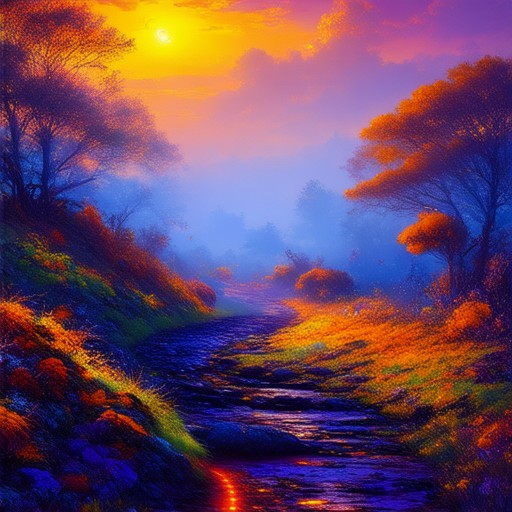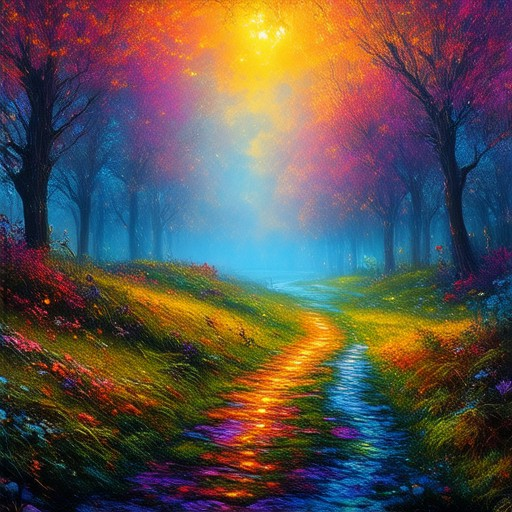Visual art techniques are the cornerstone of artistic expression, offering a pathway for creators to translate their imagination into tangible forms. Whether through painting, sculpture, photography, or digital media, mastering these techniques allows artists to craft pieces that resonate emotionally and intellectually. From the fundamental elements of art to the sophisticated styles that define movements, visual art techniques encompass a vast spectrum of methods and tools designed to inspire creativity and innovation. Understanding these techniques not only enhances one’s ability to express themselves but also deepens their appreciation for the evolution of art across different cultures and eras. This guide delves into the essential aspects of visual art techniques, exploring everything from basic principles to contemporary approaches, providing a comprehensive resource for anyone looking to refine their artistic skills or gain a deeper understanding of the art forms they admire.

Visual Art Techniques
Visual art techniques encompass a wide range of methods used to create and express visual ideas. These techniques are often categorized based on the medium or tool used, as well as the style or approach taken by the artist. Below are some of the most common visual art techniques:
- Drawing
Drawing is one of the most fundamental visual art techniques. It involves creating images or designs using lines, shapes, and shading. Common types of drawing include: - Sketching: Rapid, freehand drawing to capture ideas or scenes.
- Shading and tonality: Using light and dark tones to create depth and dimension.
- Perspective drawing: Creating a sense of space and depth on a flat surface.
- Gesture drawing: Focusing on the movement and contour of a subject.
- Painting
Painting involves applying paint to a surface to create visual artwork. Different types of painting include: - Oil painting: Known for its rich colors and thick texture.
- Watercolor painting: Uses water-soluble pigments for vibrant, transparent hues.
- Acrylic painting: Combines the flexibility of water-based paints with the durability of oil paints.
- Gouache: A type of painting where pigment is applied to dry medium, creating bright, opaque colors.
- Printmaking
Printmaking is the process of creating prints using plates, stencils, or other tools. Common printmaking techniques include: - Lithography: Uses a metal plate to transfer images onto paper.
- Screen printing: Involves pushing ink through a stencil onto a surface.
- Etching: Creates designs on a metal plate using acid etching.
- Relief printing: Carving or modeling designs into a material for printing.
- Photography
Photography captures light and shadows to create images. Key photography techniques include: - Portrait photography: Capturing human subjects in a meaningful way.
- Landscape photography: Depicting natural scenes and environments.
- Still life photography: Focuses on inanimate objects arranged in an artistic composition.
- Fashion photography: Showcasing clothing and accessories creatively.
- Digital Graphic Arts
Digital tools have revolutionized traditional art techniques. Common digital techniques include: - Digital painting: Using software like Photoshop or Procreate to create digital artworks.
- Collage: Combining images and textures using computer software.
- 3D modeling and rendering: Creating three-dimensional art for games, films, or exhibitions.
- Motion graphics: Integrating animation and visuals for video production.
By mastering these techniques, artists can explore diverse styles and mediums, allowing them to communicate their unique perspectives and stories visually. Whether traditional or digital, visual art techniques continue to evolve, offering endless possibilities for creativity and expression.
What Are the 7 Elements of Visual Arts?
The visual arts encompass a diverse range of mediums and techniques, each utilizing fundamental elements that define their creation and expression. Below, we explore the seven core elements of visual arts:
1. Line
Line is the foundation of visual arts, serving as both a structural framework and a means of expression. Straight or curved lines create edges, boundaries, and paths that guide the viewer’s eye through a composition. Lines can be thin, thick, continuous, or broken, contributing to the overall rhythm and movement of a work.
2. Shape
Shape is the three-dimensional form or mass created by lines. Shapes can be organic, like curves or blobs, or geometric, such as squares, circles, or triangles. Shapes often symbolize concepts, evoke emotions, and provide balance within a piece.
3. Form
Form refers to the three-dimensional object or entity depicted in a work. It can be abstract or representational, giving depth and volume to a composition. Form is often achieved through shading, perspective, and texture.
4. Space
Space is the area within a work, defined by the arrangement of shapes, lines, and forms. Positive space is the actual subject matter, while negative space is the empty areas around it. Effective use of space creates harmony and can imply depth or isolation.
5. Value
Value refers to the lightness or darkness of colors and tones. It creates contrast and helps establish depth and dimensionality. High contrast draws attention to specific elements, while subtle variations in value can convey mood and atmosphere.
6. Color
Color is the element that adds vibrancy and emotion to art. It can be used to highlight, unify, or divide a composition. Colors may evoke feelings ranging from calmness to excitement, depending on their hue and saturation levels.
7. Texture
Texture describes the surface quality of a work, whether it’s smooth, rough, flat, or three-dimensional. Texture can be implied through shading or brushwork, or it can be created using materials like canvas, paper, or paint.
How These Elements Intersect
Understanding these elements is crucial for creating cohesive and impactful art. For instance, strong lines can define shape and form, while color and texture can influence the overall mood and style of a piece. The interplay between these elements often determines the success of a composition.
Practical Applications
These principles are applied across various art forms, including painting, sculpture, photography, and digital media. By mastering these elements, artists can communicate ideas, tell stories, and evoke emotions effectively.
By studying and experimenting with these elements, artists can unlock new creative possibilities and refine their unique styles. Whether you’re working in traditional mediums or exploring modern techniques, the fundamentals of visual arts provide a solid foundation for innovation and self-expression.

What Are the 12 Art Techniques Used by Artists?
We’ve compiled a list of 12 fundamental art techniques that every artist should be familiar with, each playing a unique role in creating masterpieces:
- Oil Painting : Known for its rich colors and texture, oil painting involves applying oil-based paints on canvas or panels. It’s ideal for detailed works.
- Watercolor : Water-soluble paints that blend beautifully, perfect for vibrant, flowing artwork and widely used in watercolor painting.
- Acrylic Painting : A versatile medium combining the flexibility of watercolor with the durability of oil paint, often used for fast-paced expressions.
- Digital Art : Utilizing software tools, digital artists create intricate pieces through editing and manipulating images digitally.
- Sculpture : Creating three-dimensional forms from various materials like clay, marble, or resin, allowing artists to bring concepts to life spatially.
- Photography : Capturing moments in time through the lens, photography bridges art and reality, offering a unique perspective.
- Printmaking : Reproducing images onto surfaces using methods like etching, lithography, or screen printing, enabling mass production of artistic designs.
- Fine Art : Focusing on high-quality craftsmanship and emotional expression, fine artists often explore personal themes and styles.
- Street Art : Public art forms like graffiti and murals that challenge traditional norms and resonate with urban environments.
- Calligraphy : Elegant handwriting art, often used in typography and sign-making, requiring precision and artistic control.
- Ceramics : Involving the creation of pottery and ceramic objects, requiring skill in both form and function.
These techniques cover a broad spectrum of artistic expression, from traditional mediums to contemporary innovations. Whether you’re a seasoned artist or just beginning, exploring these techniques can unlock new creative possibilities and help you develop a unique style.

What Are the 5 Examples of Visual Arts?
Visual arts encompass a wide range of creative disciplines that involve the creation of visual works intended to convey ideas, emotions, or beauty. Here are five primary examples:
- Painting : A traditional medium where artists use brushes, colors, and canvas to create two-dimensional images. Paintings can depict landscapes, portraits, abstract concepts, or historical scenes.
- Drawing : A fundamental art form that uses marking instruments like pencils, pens, or charcoal to create line-based works. Drawings can be detailed studies, conceptual sketches, or finished pieces.
- Printmaking : An art technique involving the transfer of images onto surfaces like paper or fabric using methods such as screen printing, etching, or lithography.
- Sculpture : Three-dimensional artwork created by shaping materials like clay, stone, metal, or wood. Sculptures can be functional or purely decorative, representing a variety of themes and styles.
- Photography : The art of capturing light and shadows to create permanent images. Photography can be black-and-white, color, digital, or film-based, covering genres like portrait, landscape, and still life.
These art forms collectively form the backbone of visual expression, influencing everything from fine art to commercial design. Explore these mediums and discover how they continue to evolve with modern tools and technologies.
Visual Art Categories
The world of visual art encompasses a diverse range of mediums and styles, each contributing uniquely to the artistic landscape. Below are the four primary categories of visual art, offering a comprehensive overview of their nature and applications:
- Painting : Painting is one of the most widely recognized forms of visual art. It involves creating images on surfaces like canvas, paper, or walls using paints, colors, and brushes. Paintings can depict realistic scenes, abstract concepts, or emotional expressions. Artists like da Vinci and Monet have left lasting legacies in this medium.
- Sculpture : Sculpture is the three-dimensional aspect of visual art, where artists shape materials like clay, stone, metal, or wood into three-dimensional forms. Statues, statuesque figures, and installations all fall under this category. Artists such as Michelangelo and Rodin are celebrated for their contributions to sculpture.
- Photography : Photography emerged as a modern art form in the late 19th century. It involves capturing light and shadows on a sensitive surface to create permanent images. From fine art photography to street photography, this medium has evolved significantly and continues to influence contemporary art.
- Architecture : While often considered a separate field, architecture is deeply intertwined with visual art. Architects design buildings and structures that not only function but also inspire awe and admiration through their aesthetic appeal. The blend of functionality and artistry in architecture makes it a unique category within the broader spectrum of visual arts.
Each category of visual art offers a distinct way of expressing creativity and emotion. Whether through the stroke of a brush, the manipulation of materials, or the capture of a moment in time, these forms continue to enrich our lives and cultural heritage.
For more insights into exploring these art forms, visit [Artful Journey](https://artfulljourney.com/) to discover tutorials, resources, and inspiration for artists and enthusiasts alike.

What Are the 5 Visual Elements of Art?
- Color : The use of hues and tones to create mood and emphasis.
- Form : Three-dimensional shapes and structures created through mass and volume.
- Line : Straight or curved lines that define edges, movement, and direction.
- Shape : Two-dimensional outlines that enclose area and convey meaning.
- Texture : Surface qualities ranging from smooth to rough, adding depth and interest.
Understanding these elements allows artists to manipulate their creations effectively, leading to expressive and meaningful artwork.




0 Comments